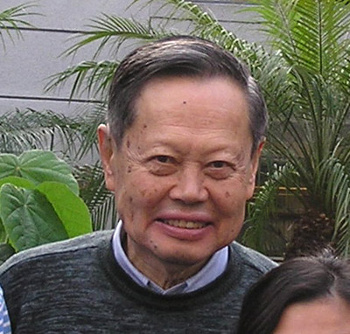
C.N. Yang
February 27, 2017 Physicist, Chen-Ning Yang, who is usually identified as "C.N. Yang" in the scientific literature, was the recipient of the 1957 Nobel Prize in Physics which he shared with fellow physicist, Tsung-dao Lee, for their prediction of parity non-conservation in processes that involve the weak nuclear force. The weak nuclear force is one of the four known fundamental forces of nature that include the strong nuclear force, gravitation, and electromagnetism. The weak force and electromagnetism are now thought to be manifestations of a single force, the electroweak force, that will be evident at very high energies (about 100 GeV). The weak force mediates nuclear reactions that involve beta decay or alpha decay. Before Yang and Lee's theory, it was thought that such reactions would appear the same when viewed in a mirror. This parity-inversion symmetry is one of the many symmetries seen in physics. I wrote about symmetries in an earlier article (CPT Symmetry, October 29, 2015). | C. N. Yang as he appeared about a decade ago. (Via Wikimedia Commons.) |
 |
| The presentation to C.N. Yang on the occasion of his 90th birthday. (Modified arXiv image from Ref. 1.)[1] |
Statistical MechanicsWhile I'm not skilled in particle physics and not comfortable reading papers that are mathematically dense, I did work in the field of superconductivity for a time. In this area of condensed matter physics, Yang and co-author, Nina Byers, explained the magnetic flux quantization in superconducting rings observed at Stanford University (Stanford, CA) by Bascom S. Deaver and William M. Fairbank.[3-4] In such rings, the magnetic flux is quantized in units of hc/2e, where h is the Planck constant, c is the speed of light, and e is the electric charge. The quantum of magnetic flux is 2.0678 x 10-15 weber. One important feature of this equation is the factor of two. The BCS theory of superconductivity, published in 1957, predicted that supercurrent is carried by electron pairs, called Cooper pairs. While this theory explained many unusual features of superconductivity, such as the isotope effect, flux quantization very dramatically provided evidence for Cooper pairs.[5] The quantum of magnetic flux can be measured to great precision using Josephson junction devices. Combining such a measurement with the quantum Hall effect allows a very accurate estimate of the Planck constant. The quantum Hall effect gives a value for an electrical resistance RK called the von Klitzing constant, RK=h/(e2). It's interesting that there's a quantum of electrical resistance, ≈25812.80756 ohms, but it's more important that a combination of precise measurements will yield an excellent calculated value for h.
1952-Phase Transition
1957-Bosons
1967-Yang-Baxter Equation
1969-Finite Temperature
Condensed Matter Physics
1961-Flux Quantization
1962-Off-Diagonal Long-Range Order
Particle Physics
1956-Parity Nonconservation
1957-T, C and P
1960-Neutrino Experiment
1964-CP Nonconservation
Field Theory
1954-Gauge Theory
1974-Integral Formalism
1975-Fiber Bundle
 | Not NIST precision The quantum resistance value, about 25.81 kohm, as simulated with a variable resistor and measured on a digital multimeter. (Photo by author.) |
References:
- Yu Shi, "Beauty and Physics: 13 Important Contributions of Chen Ning Yang," arXiv, February 7, 2017.
- Yu Shi, "Beauty and Physics: 13 Important Contributions of Chen Ning Yang," International Journal of Modern Physics A, vol. 29, no. 17 (June 13, 2014), Article No. 1475001 (10 pages), DOI: 10.1142/S0217751X14750013.
- N. Byers and C. N. Yang, "Theoretical Considerations Concerning Quantized Magnetic Flux in Superconducting Cylinders," Phys. Rev. Lett., vol. 7, no. 2 (July 15, 1961), pp. 46-49, doi:10.1103/PhysRevLett.7.46.
- Bascom S. Deaver, Jr., and William M. Fairbank, "Experimental Evidence for Quantized Flux in Superconducting Cylinders," Phys. Rev. Lett., vol. 7, no. 2 (July 15, 1961), pp. 43-46, DOI:https://doi.org/10.1103/PhysRevLett.7.43.
- David Lindley, "Focus: Landmarks—Superconductor Quantizes Magnetic Field," Physics, vol. 8, no. 102 (October 23, 2015).